Hello everyone!I recently had the opportunity to attend a Regional Focus Seminar hosted by the California Wine Institute.
This marks my third time participating in this seminar series, following the sessions on the West Sonoma Coast and Paso Robles. Once again, I’ll be reflecting on the seminar and sharing the charm of Santa Barbara with you all.
This article is based on materials specially prepared by the California Wine Institute for the seminar, combined with my own notes.
While my blog typically leans towards writing about all kinds of extra (and possibly unnecessary!) things, this time I’m focusing on a proper recap of the seminar content—an unusually informative treat for my readers (or so I hope!).
Let’s dive right in.
Check it out!
Where is Santa Barbara?
By the way, can you immediately pinpoint Santa Barbara on the map when you hear the name?As for me, I couldn’t quite conjure up its exact location off the top of my head, so I decided to check my sommelier textbook.
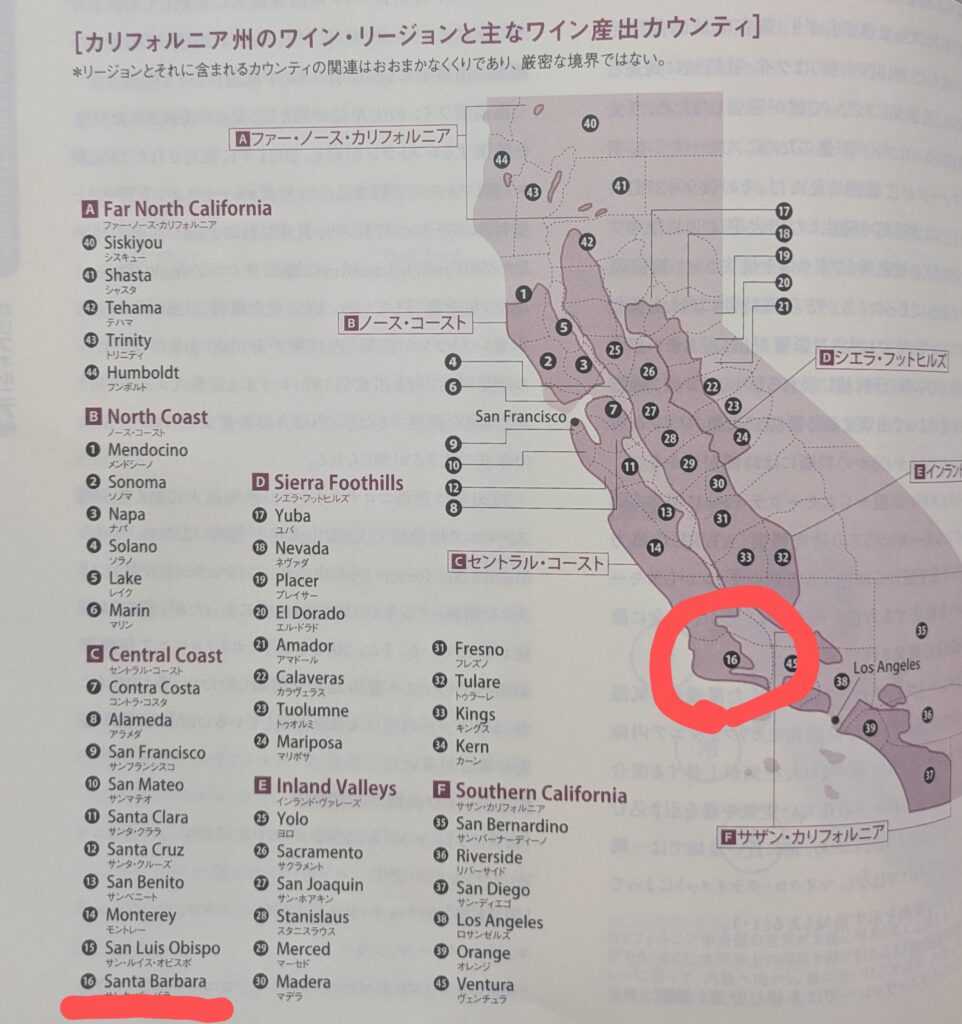
It turns out that compared to Sonoma and Napa, which are more well-known in California, Santa Barbara is located further south.In his opening remarks, Mr. Ougiya from the California Wine Institute introduced Santa Barbara in the following way.

We are truly delighted to introduce you to the captivating region of Santa Barbara, located in Southern California.This area is known for its charming Spanish-style architecture and picturesque scenery, earning it the nickname “The American Riviera.” Surprisingly, despite a population of only 80,000, Santa Barbara produces numerous world-renowned wines.Through today’s seminar, we hope you will take the time to fully appreciate the charm of Santa Barbara and the essence of the wines poured into your glass.
Although I’ve never been to Europe or America, I can imagine that Santa Barbara must be a truly wonderful region.Incidentally, the interpreter for this seminar was Ms. Kana Yamamoto. (Thank you for your excellent interpretation!)
Overview of Santa Barbara
To begin with, Mr. Douglas Margerum, a board member of Santa Barbara Vintners and owner of Margerum Wine Company, provided an explanation of the overall characteristics of Santa Barbara County.

To start with, let’s talk about the geography of Santa Barbara. Unlike other regions in California, Santa Barbara County has coastal mountain ranges that run horizontally (east to west), allowing cold air to flow from the ocean towards the land. Because of this, Santa Barbara is a south-facing town near the beach, overlooking the Pacific Ocean. However, instead of facing toward Japan, its orientation is more toward Mexico. The town of Santa Barbara has a tropical, resort-like image and is home to many celebrities. About 30 to 40 minutes by car from the town, you’ll encounter valleys—this is where the wine regions of Santa Barbara are located.
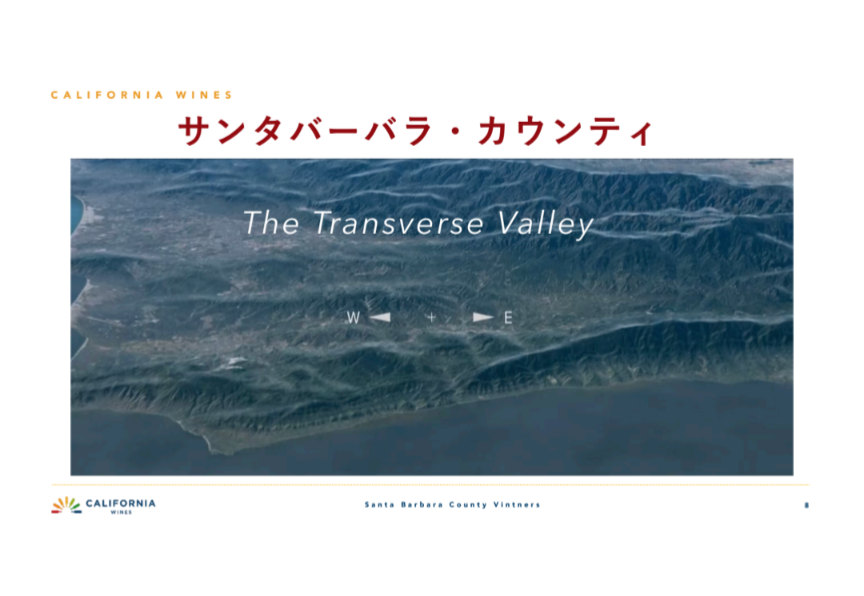

This wine region faces the ocean, making it one of the world’s rare cool-climate areas. The fog rolling in from the sea blocks the sunlight, causing temperatures to drop. As a result, the growing season for the grapevines is extended, allowing the sugar levels to rise while maintaining acidity—one of its distinctive characteristics.
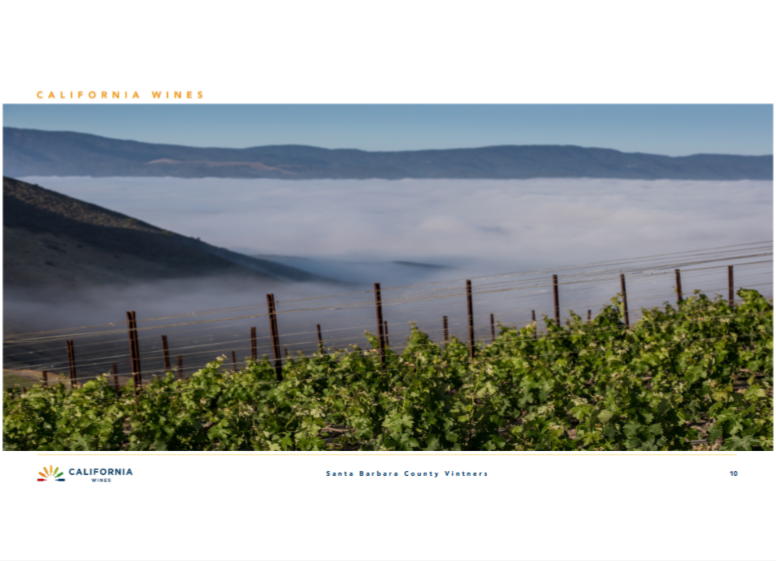

In recent years, while global warming has been progressing worldwide, this region has actually been getting colder year by year. The east-west valleys draw in cold air from the ocean, while on the eastern side, there is a desert where temperatures have been rising due to global warming.The warm air from the desert creates upward currents, pulling in surrounding air. As a result, even more cold air continues to flow into the region, and over the past six years, it has recorded its coldest temperatures.This fog also affects the harvest season, protecting the grapes from summer heat and heatwaves, allowing them to ripen fully.
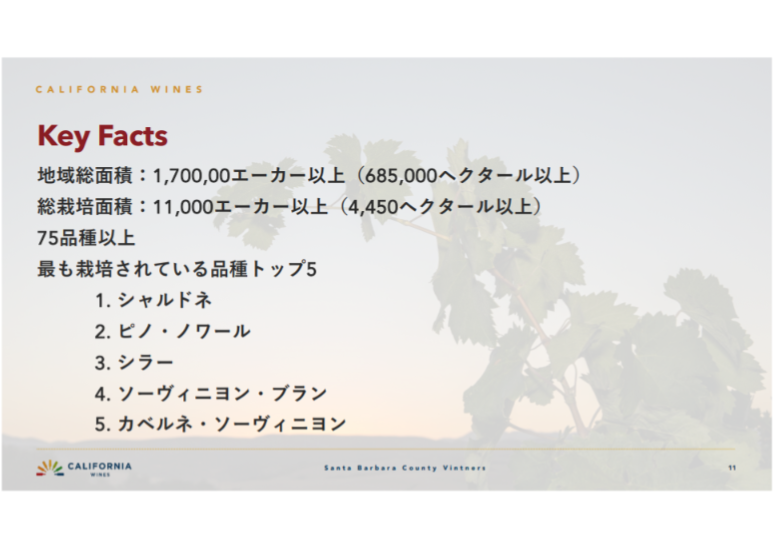

The total area of Santa Barbara County exceeds 685,000 hectares, but the actual cultivated area is limited to 4,450 hectares, where more than 75 grape varieties are grown. The main varieties cultivated are Chardonnay, Pinot Noir, Syrah, Sauvignon Blanc, and Cabernet Sauvignon.
about the seven AVAs
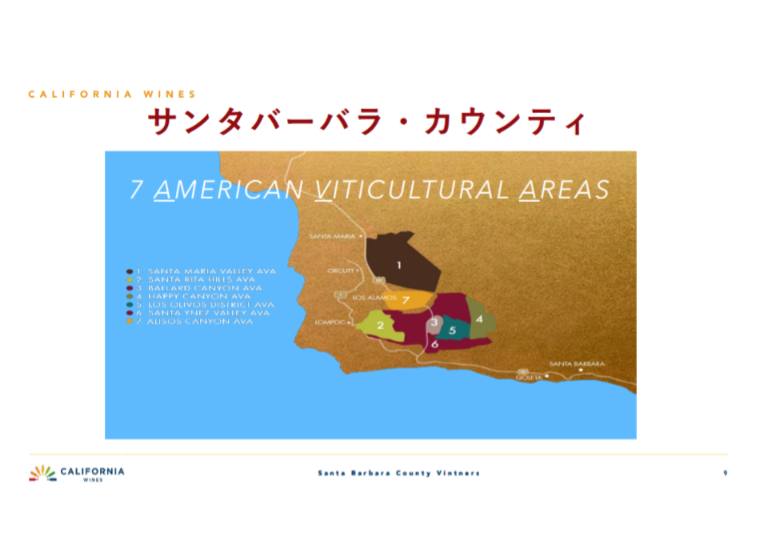
Santa Barbara County’s appellations include seven AVAs (American Viticultural Areas).
Doug introduced the unique characteristics of each AVA.
Santa Maria Valley AVA
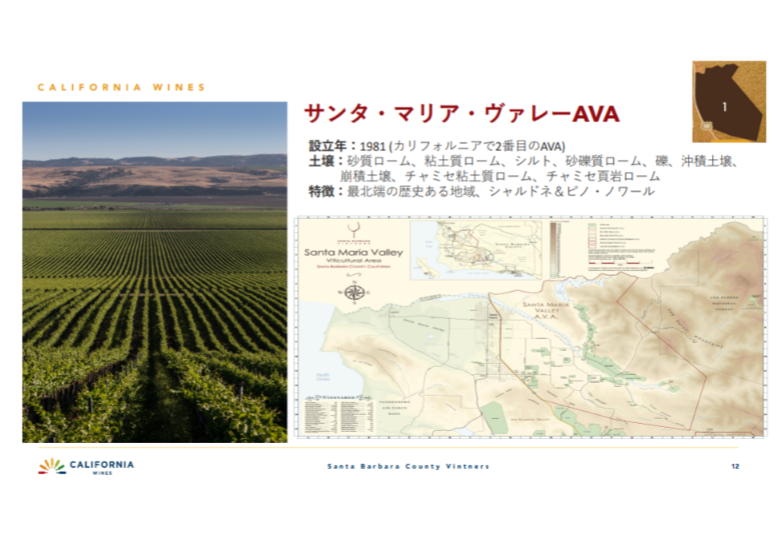
Established in 1981, it is California’s second AVA. Known especially for its Chardonnay and Pinot Noir, it gained fame through Bien Nacido Vineyard, where Au Bon Climat first produced wines from this single vineyard.
Rhône varietals are also cultivated here, adding a distinct uniqueness.
Santa Maria Valley boasts the longest growing season among the AVAs.
Sta. Rita Hills AVA
The name was changed to avoid confusion with Santa Rita in Chile. The area features soils composed of diatomaceous earth, limestone, and sand, producing exceptional Chardonnay and Pinot Noir.
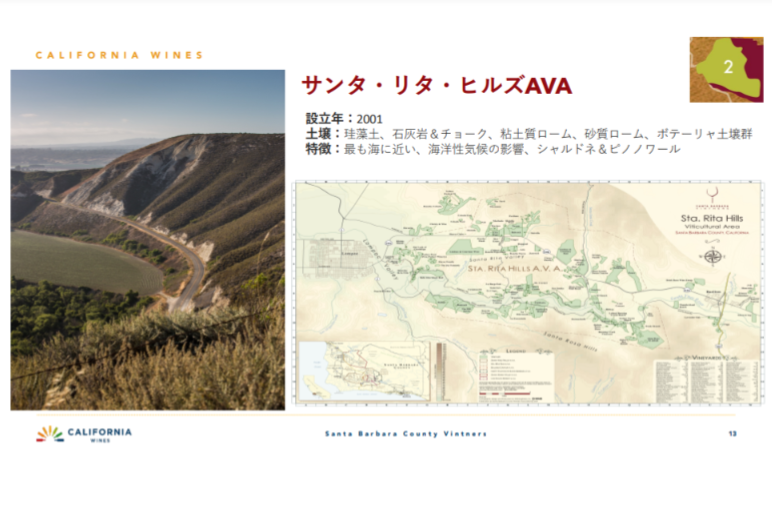
Ballard Canyon AVA
A small yet unique AVA characterized by strong winds. It is situated between Sta. Rita Hills and Los Olivos, and the wind-moderated area is predominantly planted with Syrah as its main varietal.
The region features various soil types, including clay loam and limestone, which provide excellent drainage. This stresses the vines, resulting in wines with a concentrated flavor profile.
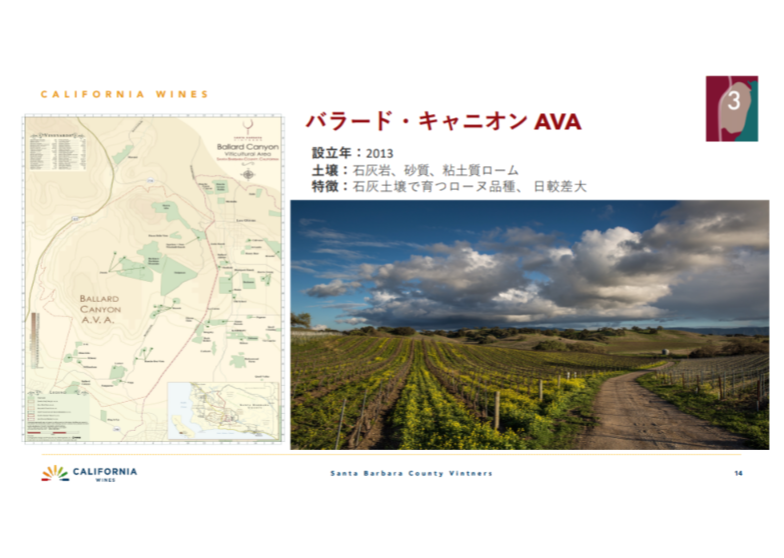
Happy Canyon of Santa Barbara AVA
This AVA is the most inland, with a history linked to the Prohibition era, during which illegal alcohol production took place. Bordeaux varietals such as Cabernet Sauvignon, Merlot, and Cabernet Franc are grown here, with Sauvignon Blanc being particularly outstanding.
The region features complex soils rich in iron, as well as ancient formations like serpentinite and granite.
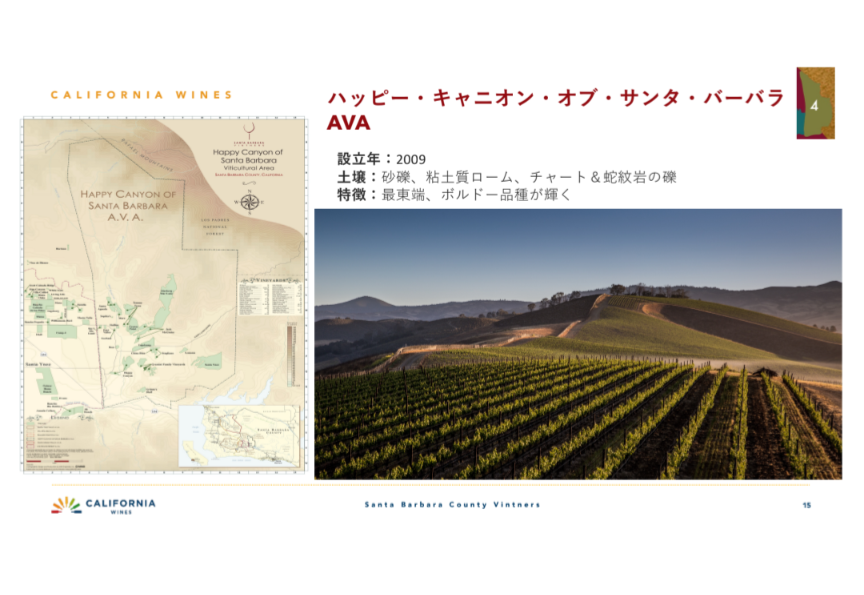
Los Olivos District AVA
A relatively large AVA where a variety of grapes are cultivated. The Sauvignon Blanc from Krentz Brunner is particularly highly regarded.
Wines made from Tempranillo and Sangiovese have also been gaining recognition recently.
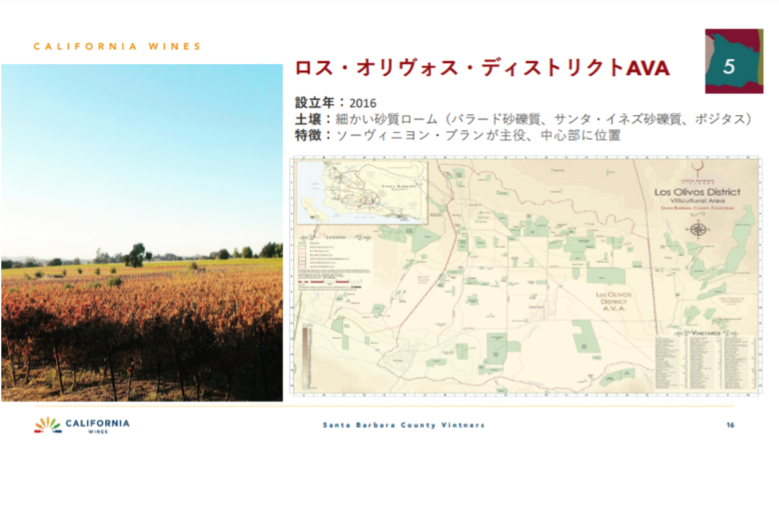
Santa Ynez Valley AVA
An AVA rich in diversity, with many grape varieties planted on the slopes of its hills. It is the largest AVA covering the entire region.
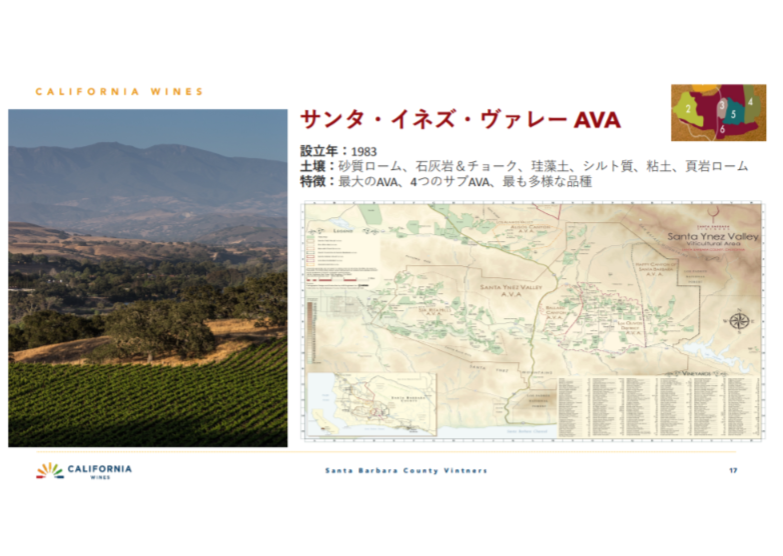
Alisos Canyon AVA
The newest and smallest AVA among them. It has a climate warmer than Santa Maria but cooler than Santa Ynez, producing particularly outstanding Cabernet Franc wines.
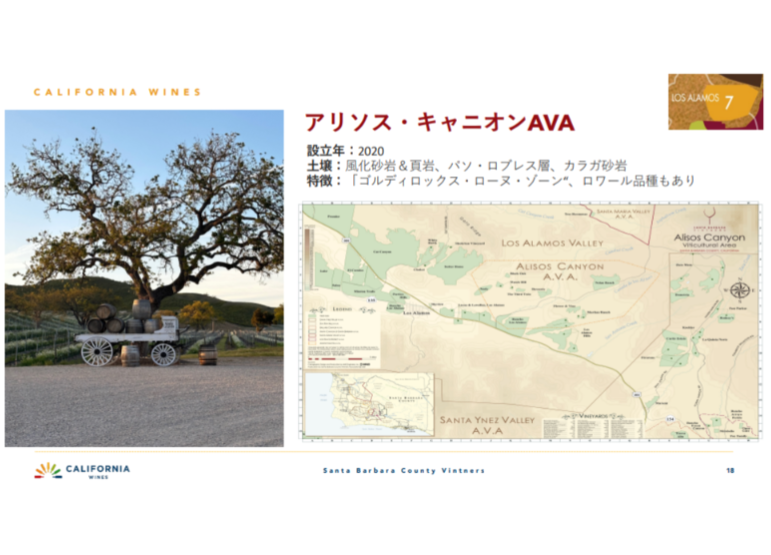

After providing an overview, I would like to take this opportunity to engage in discussions with the wonderful people here today while tasting some wines. Reflecting on my past experience as a sommelier in my younger years, I recall the valuable insights I gained when I visited Burgundy. I encourage everyone to visit Santa Barbara and experience its unique charm. We look forward to welcoming you.
Let’s Taste
From here on, the producers themselves introduced the tasting items and their wineries for the day.
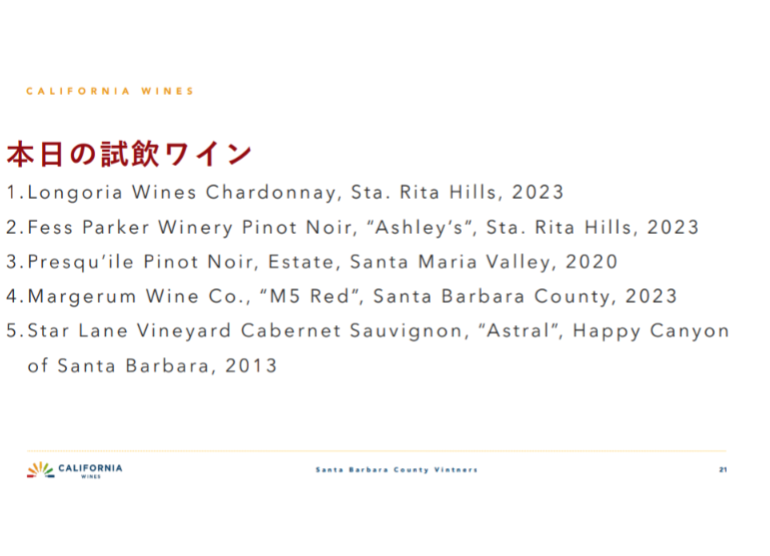
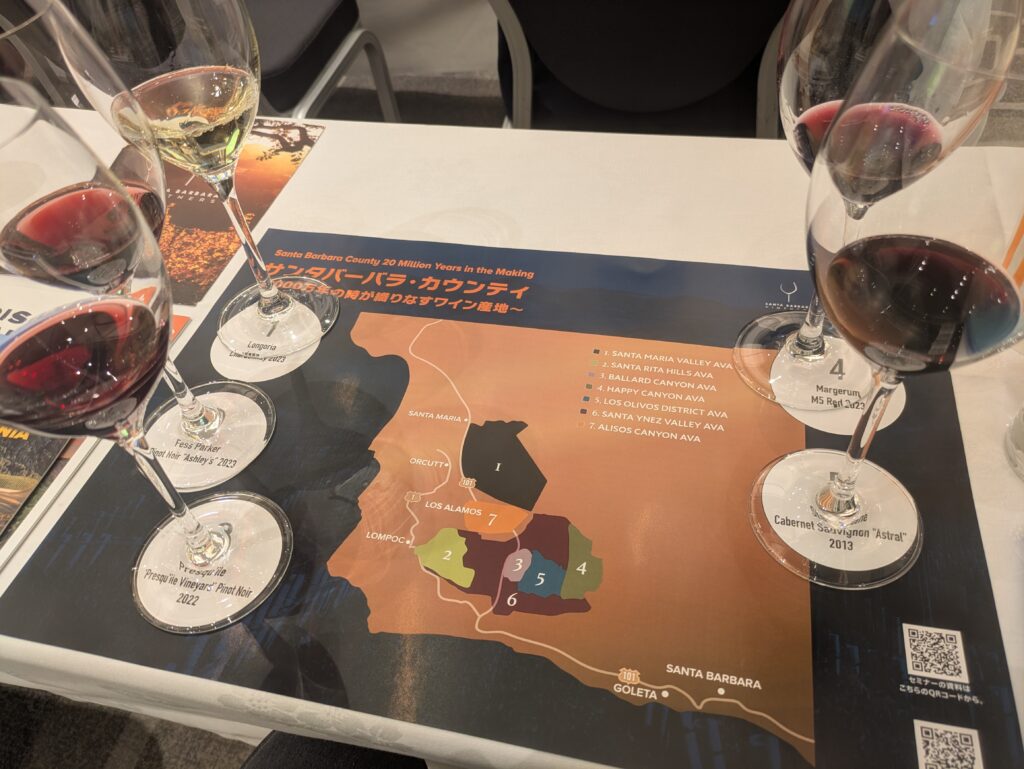
Longoria Wines
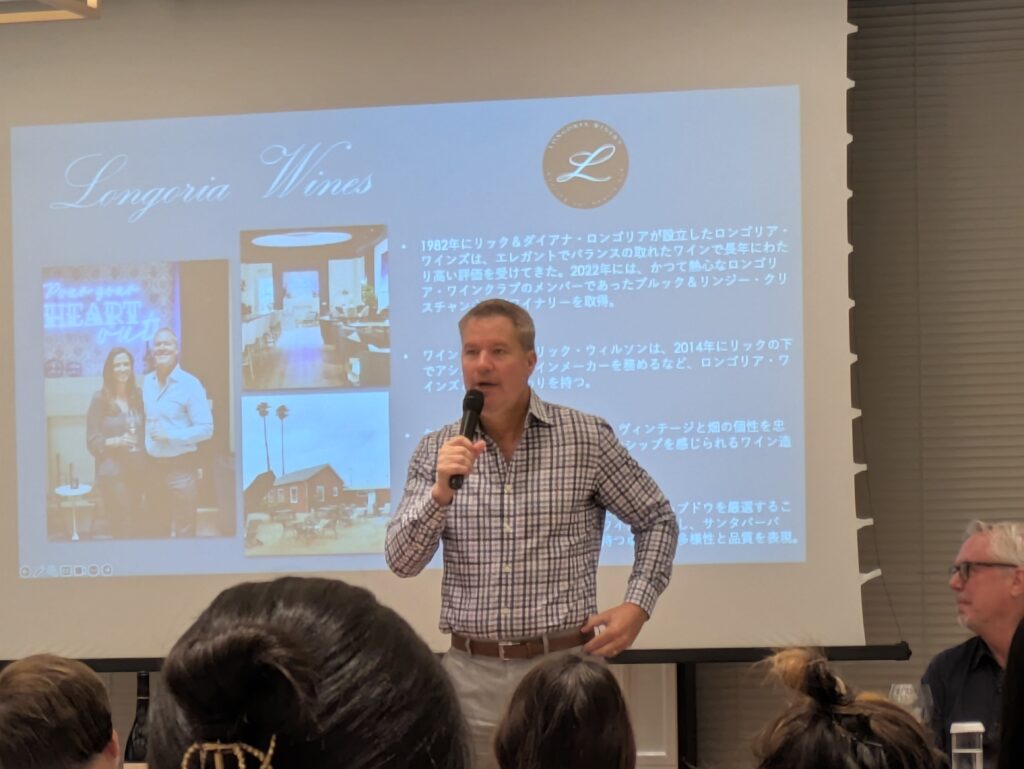
I am Brooke Christian, the owner of Longoria Wines.

The founder, Rick Longoria, has been crafting classic-style wines in this region for over 40 years. He has focused particularly on Pinot Noir and Chardonnay, which have French roots, as well as Spanish varietals influenced by Rick’s own heritage as a Spaniard. Longoria is renowned for planting the largest number of Spanish varietals in Santa Barbara.
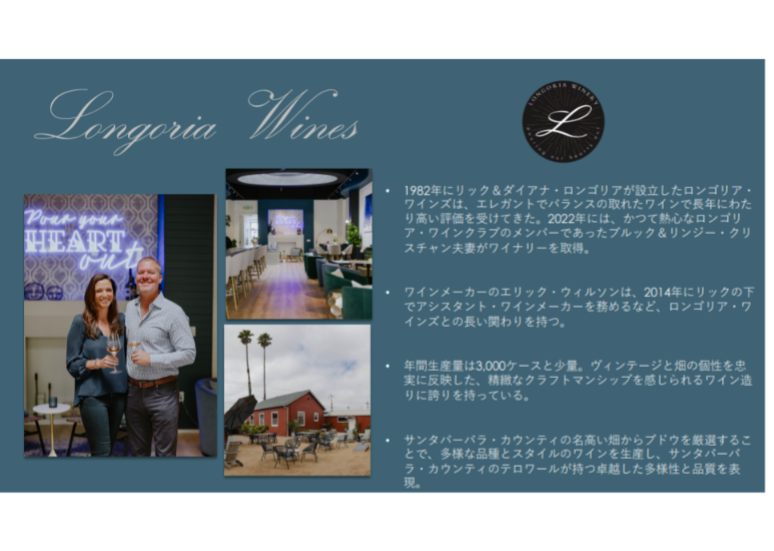
Sta Rita Hills Chardonnay 2023
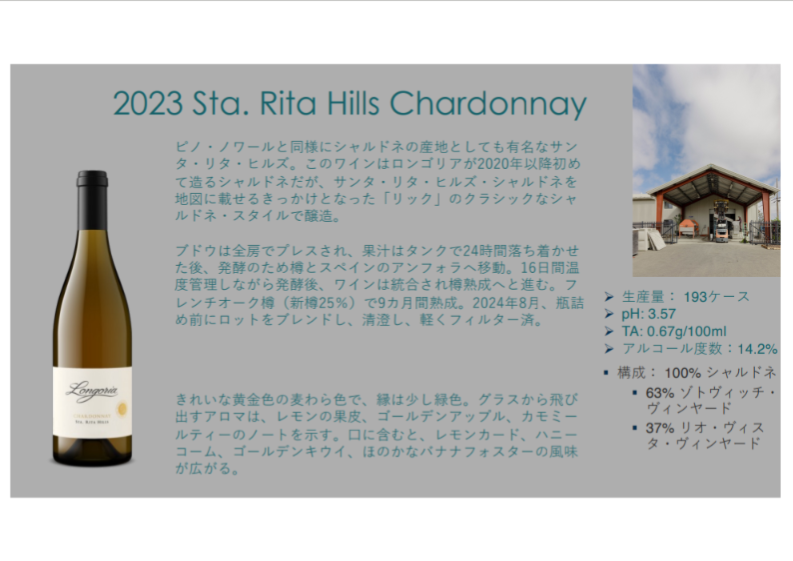

Our Chardonnay has received particularly high praise, with the one produced in Sta. Rita Hills earning a perfect score of 100 points. It is aged for nine months in 25% new oak barrels and rested in Spanish clay pots made from Spanish clay. This method suppresses oak nuances while drawing out complex character. The aroma evokes notes of apple and chamomile tea, with a light coloration.
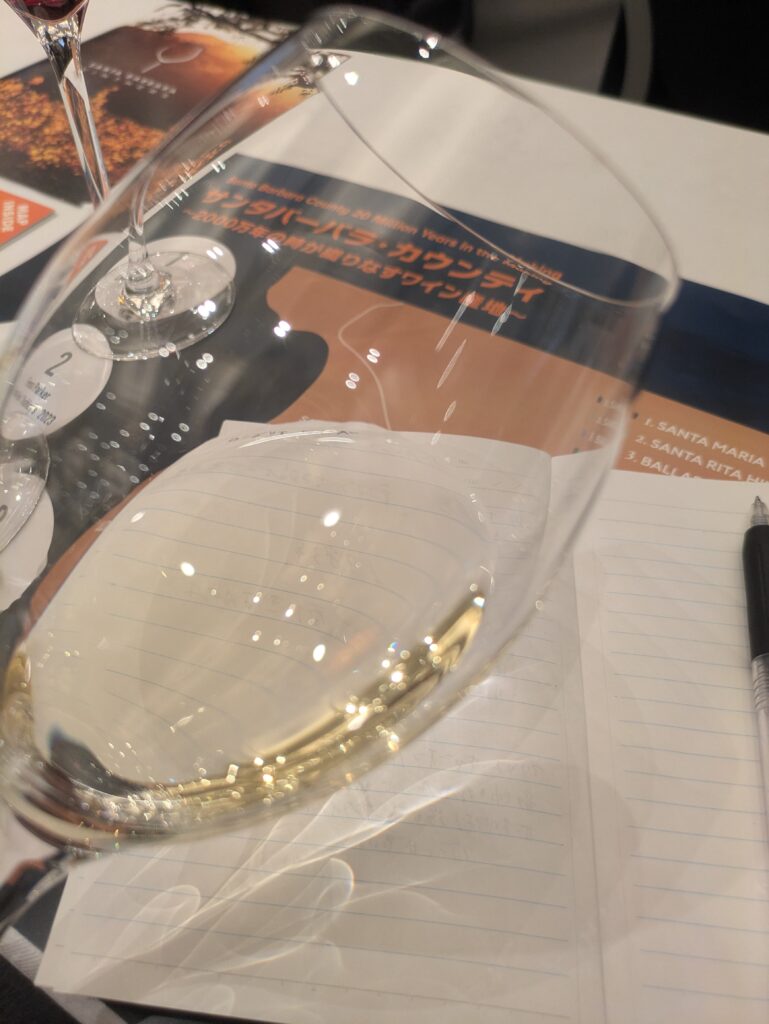
Comny’s Notes
This Chardonnay was truly delicious.
Not only did it have citrus and apple aromas, but as time passed and the temperature rose, it even revealed pineapple notes—absolutely remarkable.
The oak provided body, while the acidity was crisp and well-structured, with a long-lasting finish.
After tasting all five types of wine, revisiting this one made it shine even brighter rather than fading into the background.
The potential of the grapes must be extraordinary.
Fess Parker Winery
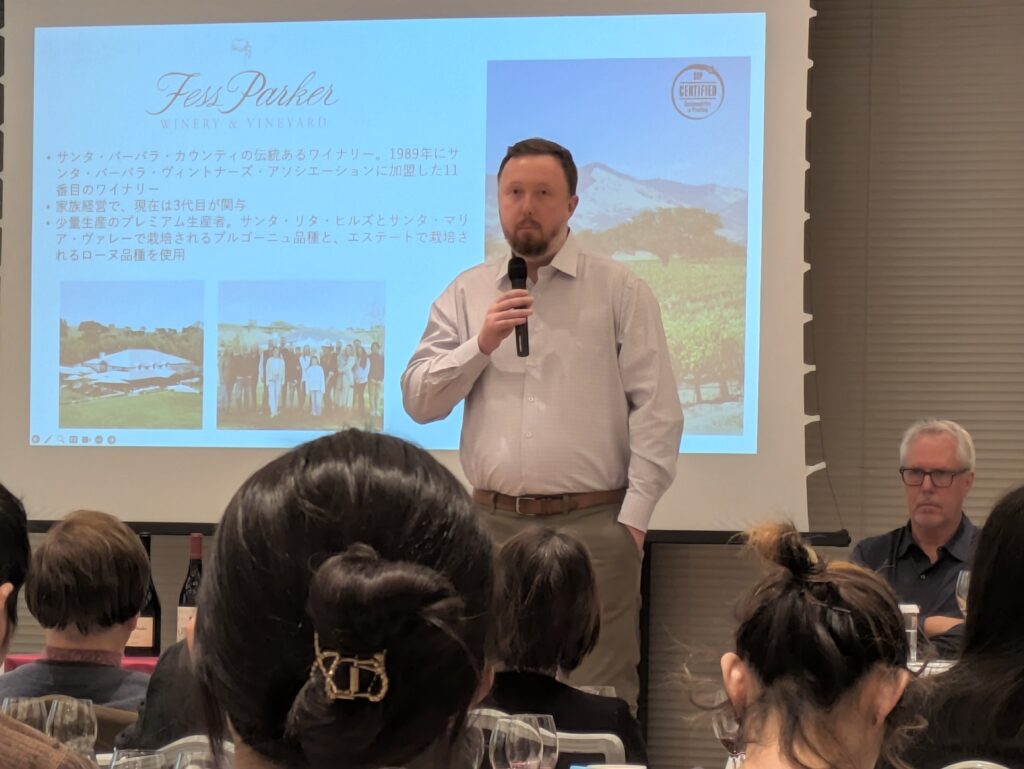
I’m Spencer Shall, the brand manager at Fess Parker Winery.

Our winery was established in 1989 by my grandfather and is run as a family business. It is a relatively new winery, being the 11th to join the Santa Barbara Vintners organization. We produce Chardonnay and Pinot Noir in the Sta. Rita Hills and Santa Maria Valley.
In particular, the Pinot Noir named “Ashley,” planted by our family in the late 1990s, perfectly showcases the cool climate of Sta. Rita Hills.
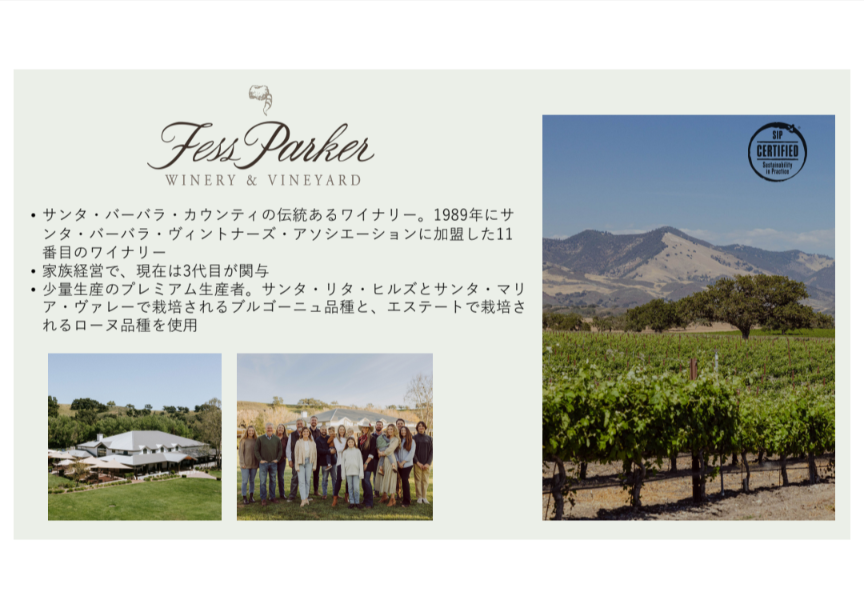
Pinot Noir “Ashley’s” 2023 / Sta Rita Hills

The 2023 harvest was characterized by consistently cool weather over an extended period, with harvesting taking place in mid-October. The wine underwent 20% whole-cluster fermentation in open concrete fermenters and was aged for 10 months in French oak barrels.
The flavor highlights red fruits at the forefront, with underlying earthy tones and umami. Its bright acidity strikes a fine balance, beautifully reflecting the distinctive characteristics of Sta. Rita Hills.
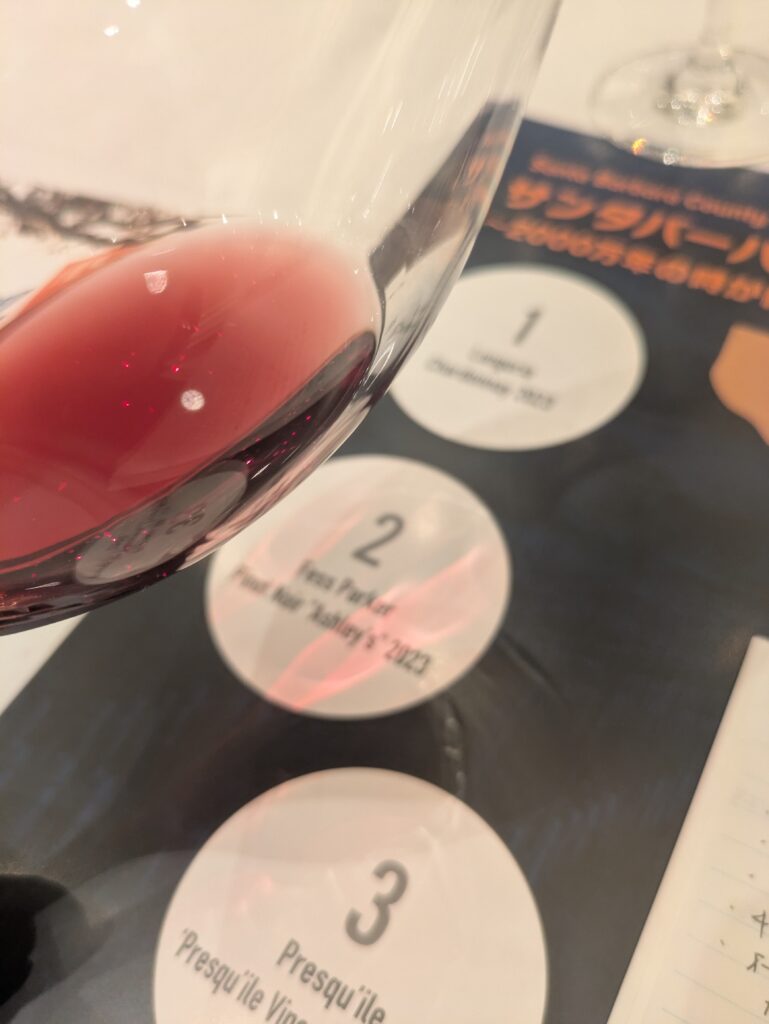
Comny’s Notes
The aroma of ripe red fruits is sweet and wonderfully vibrant.
It evokes a crystal-clear scent that reminds me of a bright blue sky and sunshine.
Despite the fullness of the aroma, the taste is unexpectedly dry, with tightened acidity landing elegantly.
The finish is long-lasting, and the tannins are astonishingly fine-grained.
Rather than black tea, it feels more like cocoa—does that make sense? (Hope you get what I mean! 😄)
This must be what they mean by “softened tannins.”
Presqu’ile
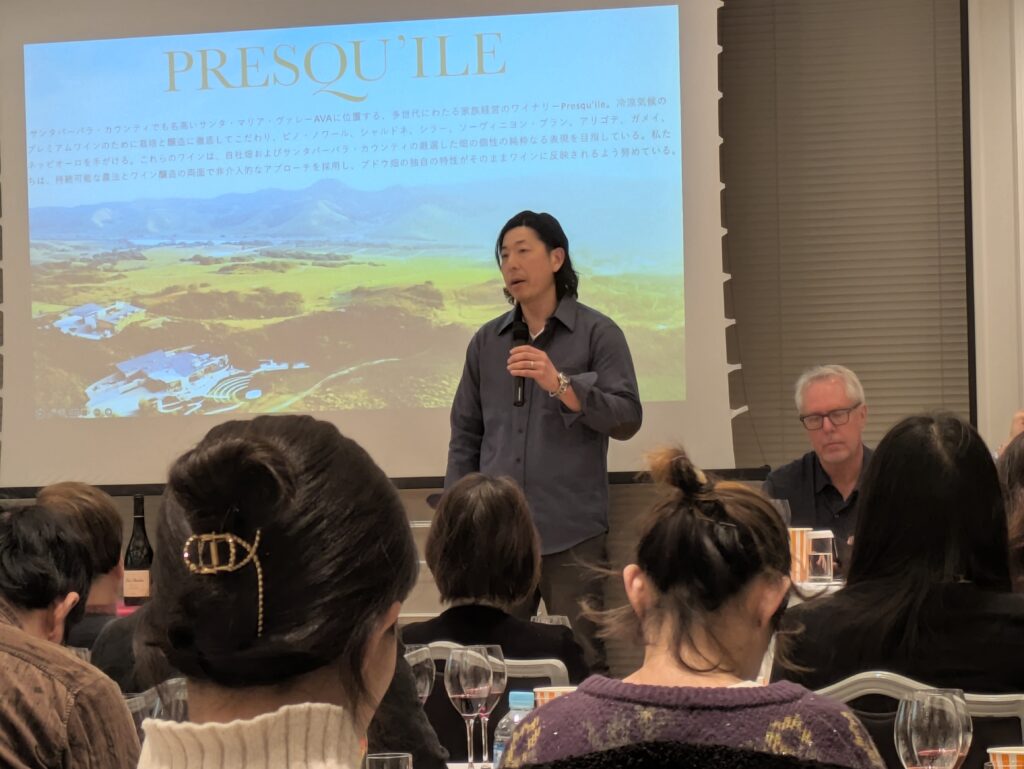

My name is Tony Chang, and I oversee global operations at Presqu’ile.
This winery was founded by the Murphy family and is located in the northernmost part of Santa Barbara, within the Santa Maria Valley AVA. It is a family-run business, with Madison (the father) and Matt (the son) handling strategic operations, while Suzanne (the mother) manages design.
The family’s retreat, owned for four generations, suffered devastating damage during Hurricane Katrina in 2005, which served as the catalyst for establishing the winery.
We produce cool-climate varieties such as Chardonnay, Pinot Noir, Syrah, and Sauvignon Blanc, in addition to small amounts of Gamay, Aligoté, and Nebbiolo.
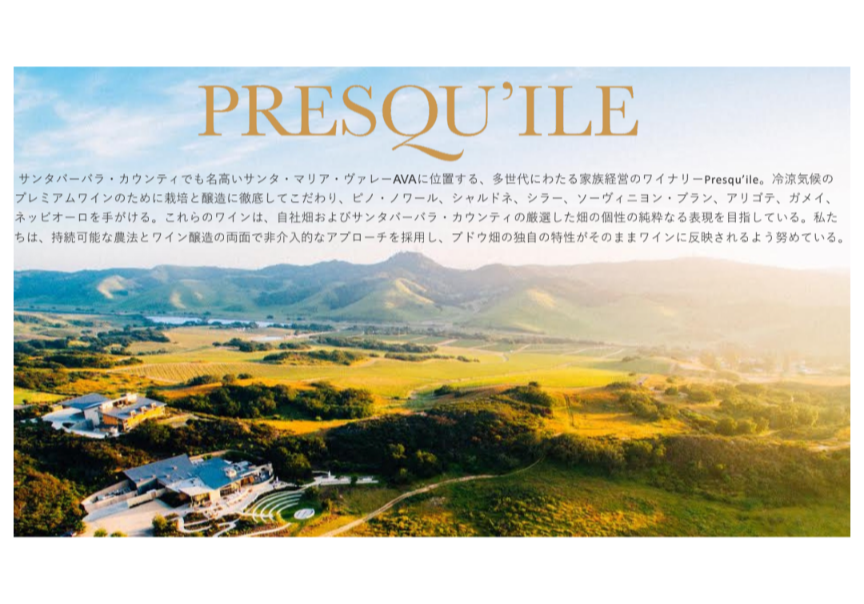
Pinot Noir Estate 2022 / Santa Maria Valley
In winemaking, we adopt a hands-off approach to minimize human intervention and highlight the unique characteristics of this exceptional region. Our winery received sustainability certification in 2014 and achieved full organic certification in 2022.
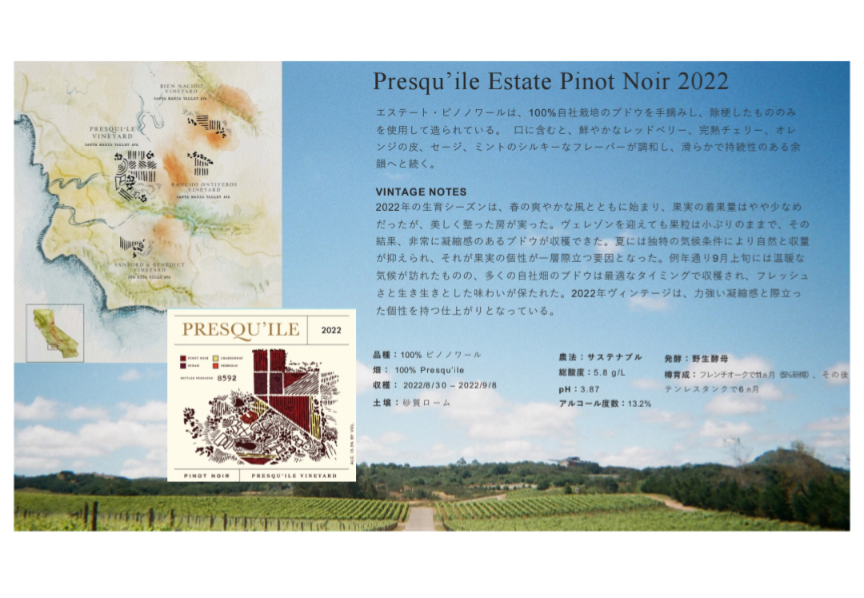

The wine we are tasting today is the 2022 Presqu’ile Vineyard Pinot Noir. Harvesting was conducted early to preserve its freshness. The light silt soil enhances the elegance of the fruit, and the grapes were fully destemmed, fermented with natural yeast, and aged for 12 months in French oak barrels.
While the light coloration suggests delicacy, the wine delivers robust fruit flavors, fresh acidity, floral nuances, and a faint saltiness reminiscent of Santa Barbara spice. It offers an experience that truly captures the diversity of Santa Barbara.
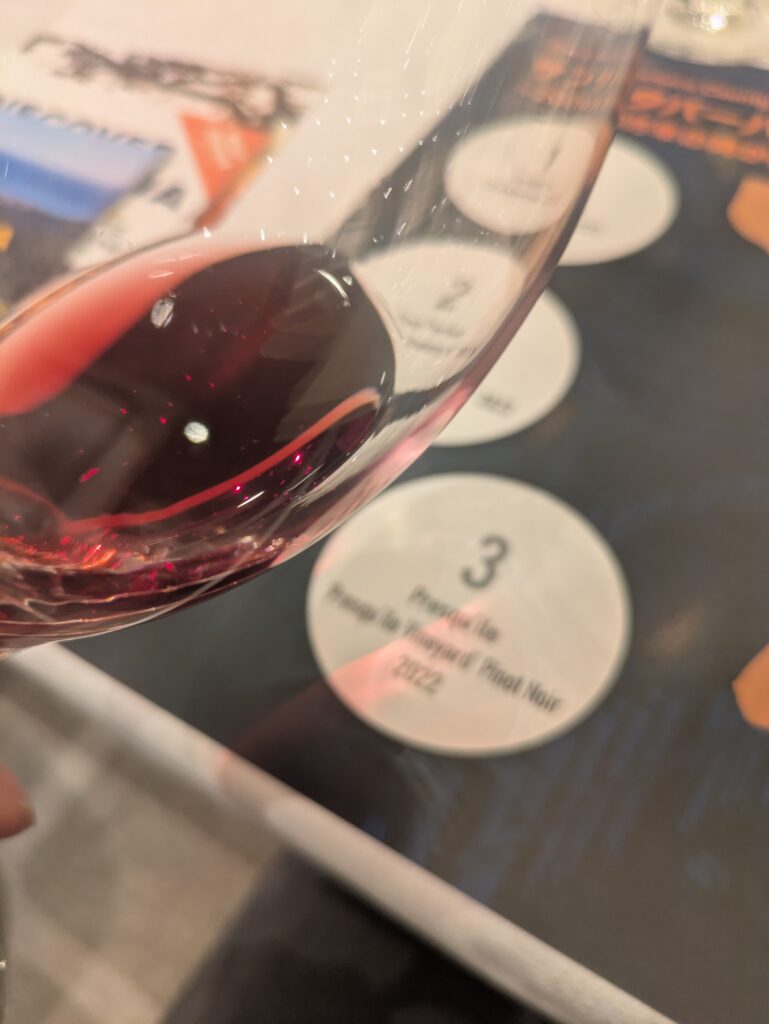
Comny’s Notes
The aroma was subtle, and the overall impression was restrained.
To be honest, I initially thought Tony had messed this one up.
However, tasting it again later at the post-seminar tasting event, it was like a completely different wine.
Fresh red fruits, flowers, and a faintly polished oak nuance came through beautifully.
I couldn’t quite detect the Santa Barbara spice, but once again, the tannins were incredibly fine.
Margerum Wine Company
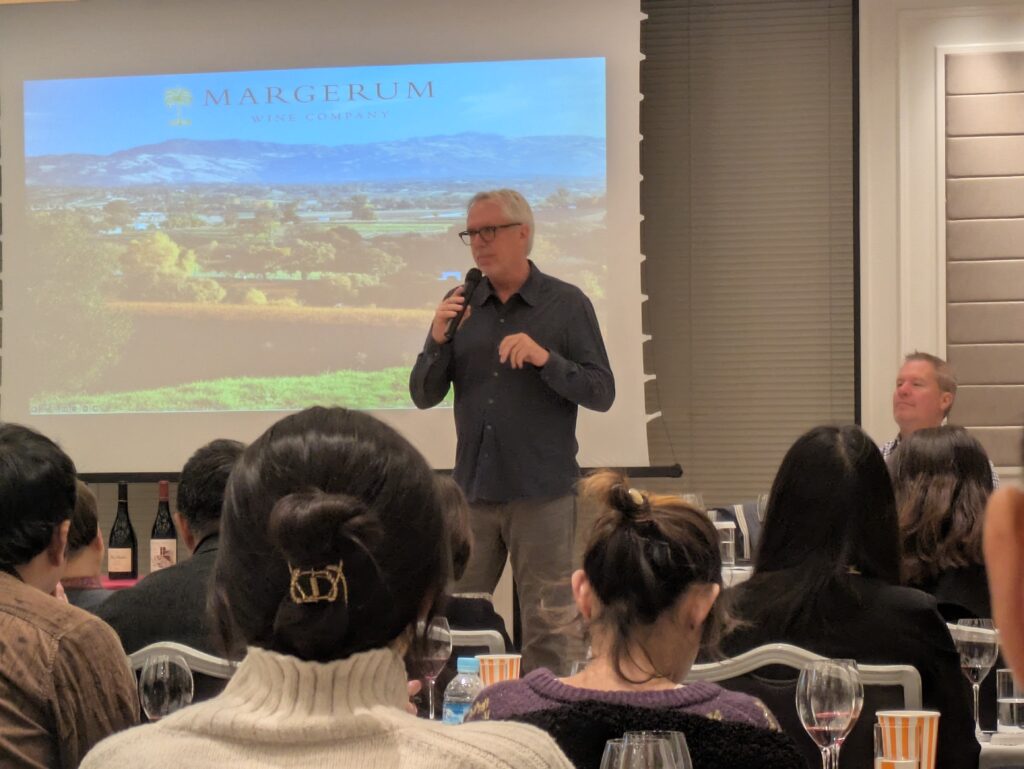

My journey in the world of wine has been a fascinating one. During high school and college, I worked in the restaurant business, driven by a passion for food and service.
When I was a senior in high school, my parents hosted an exchange student. She happened to be a woman, and I quickly fell in love with her. This led me to travel to France nearly every year to see her.
Later, I studied economics at the University of California, Santa Barbara, and graduated.
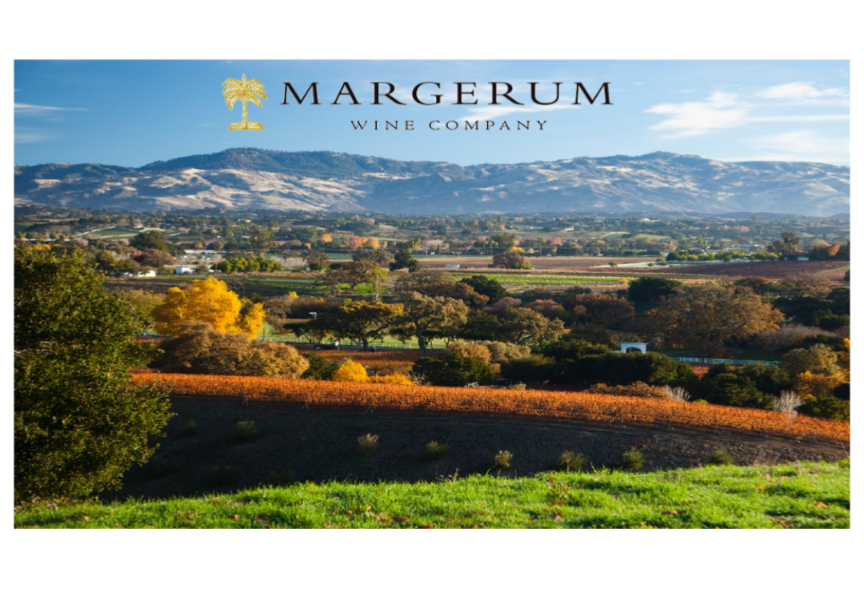

In 1981, I opened the first wine bar in the region and established the style of serving wine by the glass. At the time, there were only two wineries in Santa Barbara, so it was astonishing when my restaurant received the Wine Spectator Grand Award a decade later.
In 1986, together with Jim Clendenen (the founder of Au Bon Climat), I established a winery called Vita Nova. Later, in 1998, I founded Margerum.
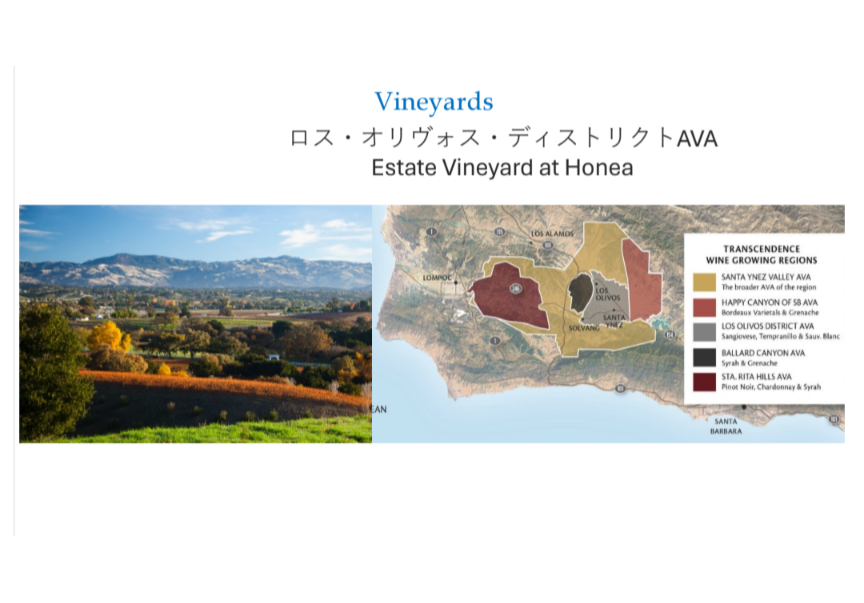

Since inviting winemakers from southern France, we have also been producing wines in the style of the southern Rhône.
M5 Red / Santa Barbara County 2023
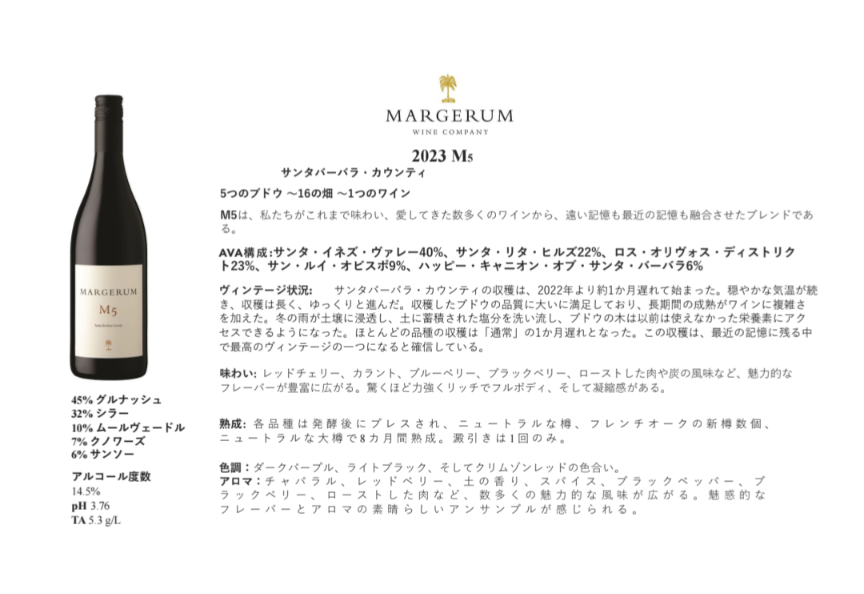

The “M5” you will be tasting today is a wine blended from five different grape varieties. This style enhances the individuality of each variety while creating a more complex flavor profile. M5 is primarily made from Grenache, with Mourvèdre, Cinsault, Counoise, and Syrah blended in.
Although it has a light color, it offers robust fruit flavors and an elegant profile when tasted. We hope you enjoy its fresh and well-balanced taste.
Our winemaking process follows traditional methods, including punch-down fermentation, followed by aging in old barrels. The wine is not racked; instead, it is aged with the lees to increase interaction. This generates carbon dioxide during fermentation, which protects the wine from oxidation, allowing us to minimize the addition of sulfur dioxide (SO2) as a preservative.
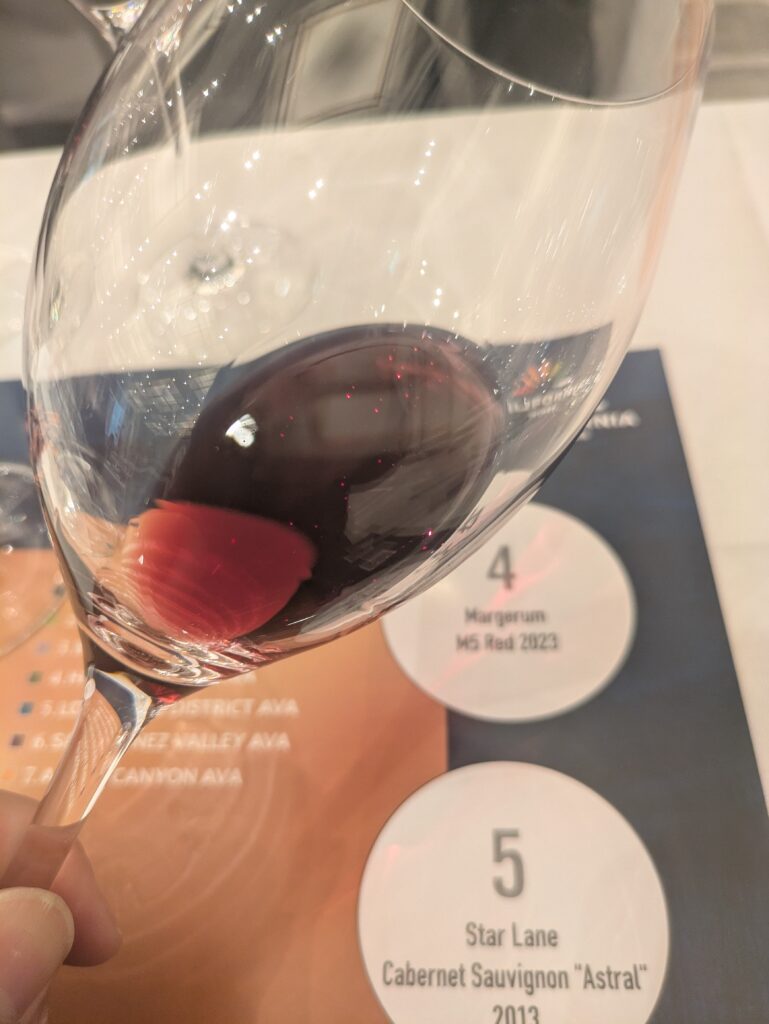

Some of you might think that screw caps don’t allow any oxygen to pass through, but the ones I use are oxygen-permeable screw caps (developed in the last 10 years, apparently). Thanks to these caps, they function similarly to cork, enabling wines to age properly for up to 20 years.
Comny’s Notes
Honestly, I feel that without being told, one might not realize this is made from Rhône varietals (just my personal opinion).
Compared to the Pinot tasted just before, the color is definitely deeper.
Perhaps due to the blend of five (or six) different varieties, it is highly complex, with an acidity that subtly evokes the impression of plums.
It’s fresh without feeling unripe or green.
The serving temperature felt slightly on the cooler side, but as time passed, the wine revealed various facets, which was truly intriguing.
Star Lane Vineyard


Hello, I’m Tyler Thomas from Star Lane Vineyard. I am responsible for winemaking at both Star Lane and the Dierberg family wineries.
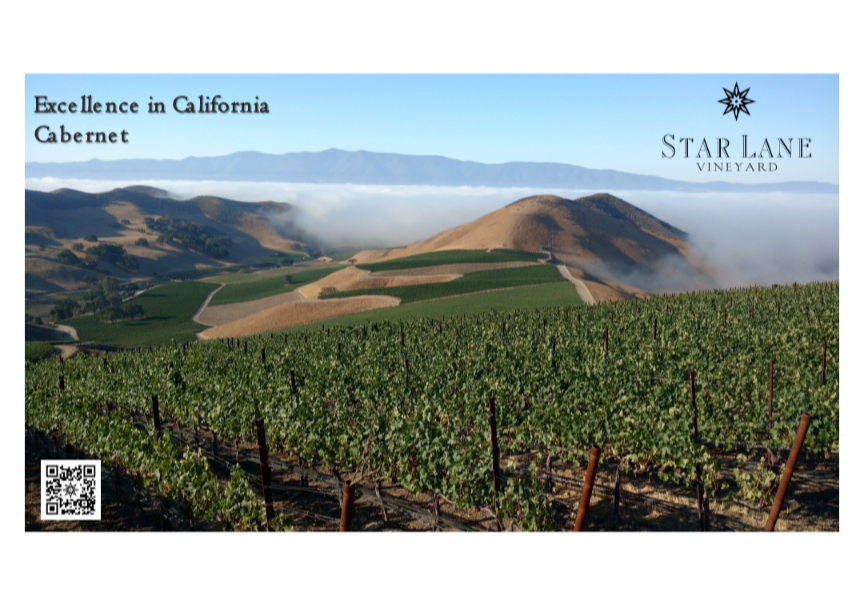

Star Lane Vineyard produces world-class, exceptional Cabernet wines. This photo was taken at 9 a.m. during summer. The Happy Canyon region is far from the ocean, situated at the edge of where the coastal fog reaches. As a result, the area receives early sunlight and has long daylight hours, making it warmer and more suitable for cultivation compared to other regions.
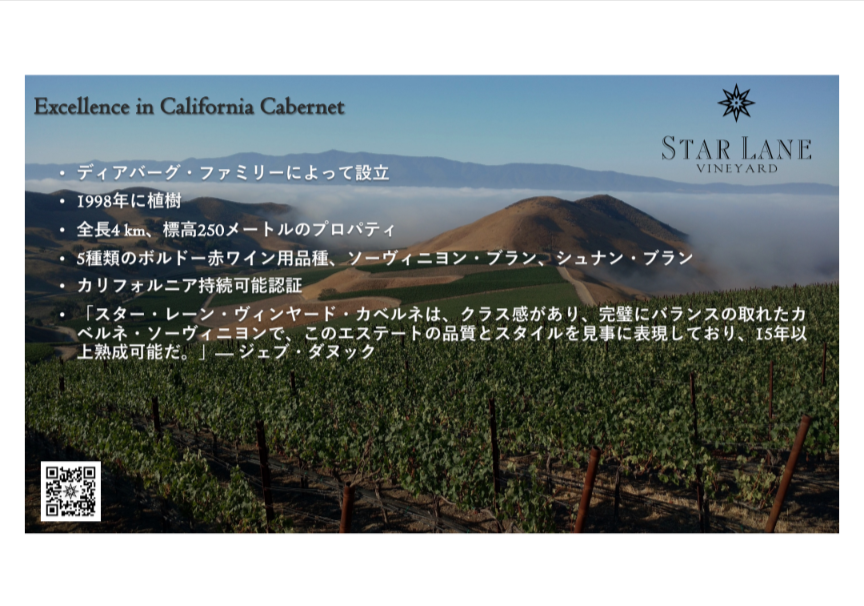

The Dierberg family has been operating wineries in Missouri since the 1970s, crafting wines there for 25 years. However, in pursuit of high-quality world-class Cabernet, they discovered their current location in 1995 and planted vines in 1998.
Their vineyard spans 4 kilometers, with a 200-meter elevation difference. Within this area, they cultivate five Bordeaux varietals, primarily Cabernet Sauvignon, while also planting small
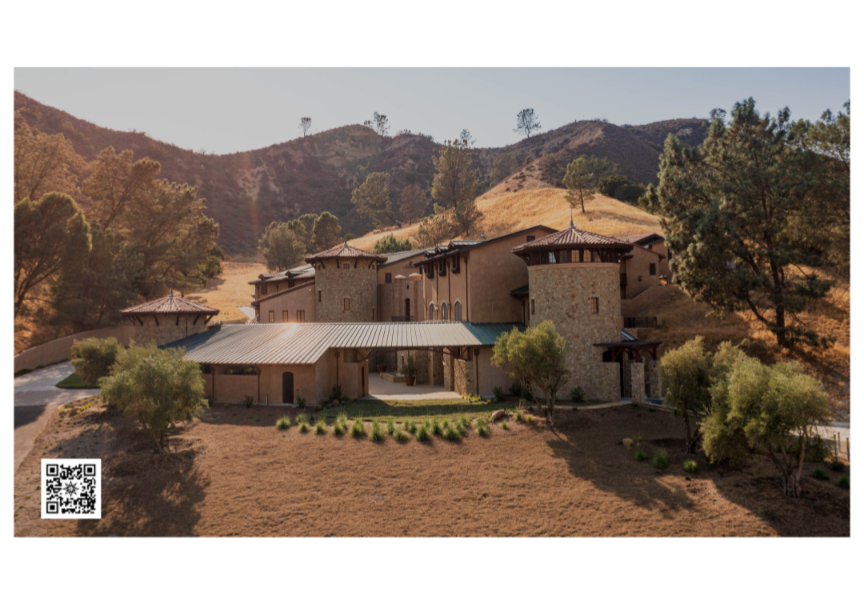

When I joined this company in 2013, I asked the owner, Dierberg, “What is your plan for the next 30 years?” He replied, “I’m not thinking about 30 years. I have a 250-year plan. Our goal is to continue making exceptional Cabernet Sauvignon in California and eventually pass it on to our children and grandchildren.”
Together with the second generation, Michael and Anne, I am engaged in work that looks ahead 10 generations, from grape cultivation to winemaking.
Cabernet Sauvignon “Astral” 2013 / Happy Canyon of Santa Barbara

The wine style aims to emulate the traditional classic style of Bordeaux. While located in a warm region, it feels cooler compared to Napa or Sonoma, allowing you to enjoy a fresher experience than typical Californian Cabernets.
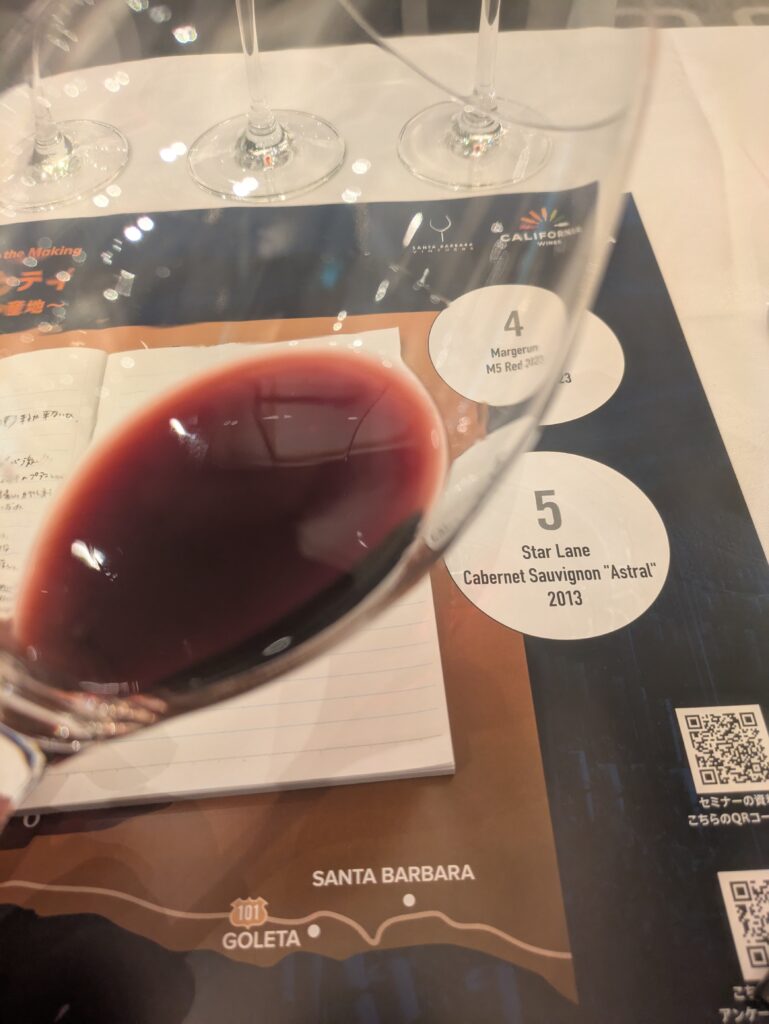

The wine you will be tasting today is the 2013 vintage, the first one I created after joining the company. This wine has been selected from a program designed for the Japanese market, where it undergoes aging for 10 to 12 years. I hope you can appreciate the significance of crafting a world-class Cabernet through this high-quality, complexly aged wine.
This wine is made from Cabernet selected from three exclusive vineyard blocks, all planted on their own roots. One of these blocks is located at a higher elevation. Fermentation is done slowly using natural yeast, with careful extraction to ensure a smooth texture. It is aged for two years in French oak barrels (65% new oak) before bottling. This reflects a simple yet high-quality approach to winemaking.
Comny’s Notes
This Cabernet was truly amazing.
Honestly, I think it’s genuinely world-class.
The aroma is deeply rich, with well-ripened qualities.
A unique interplay of various elements creates a sense of both concentration and complexity that’s hard to put into words.
It’s not overly heavy but elegantly balanced and refined, leaving a smart impression.
You don’t need food to enjoy this wine—just time.
Savoring it slowly in a large glass would undoubtedly be the ultimate experience.
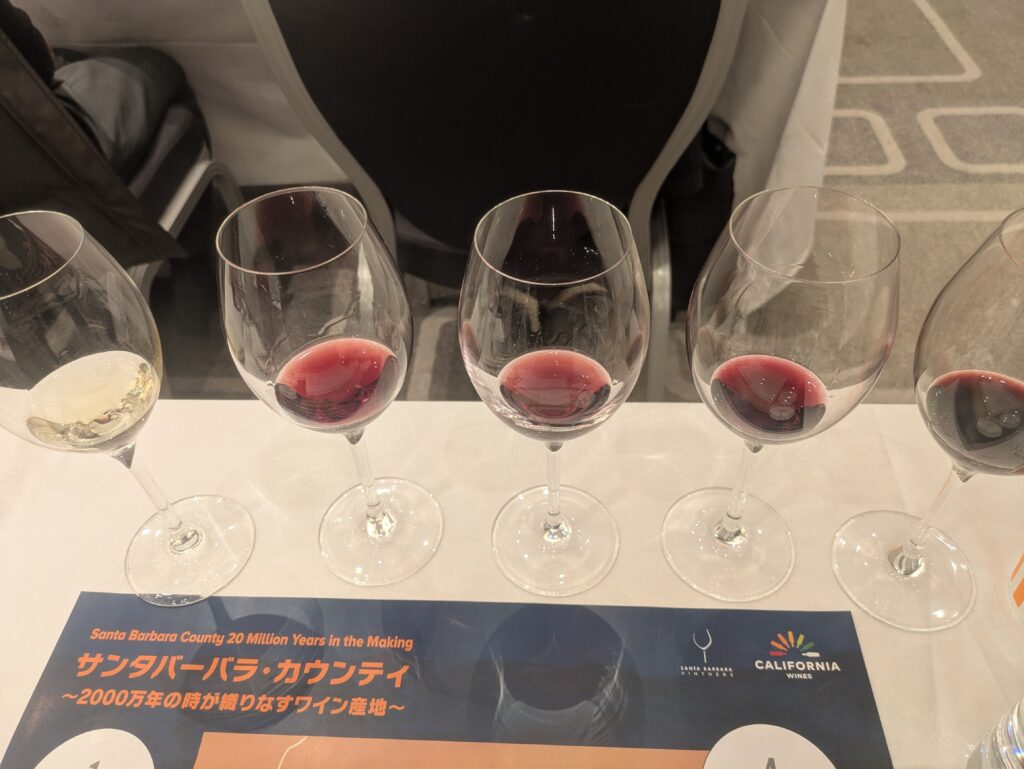
Closing Remarks
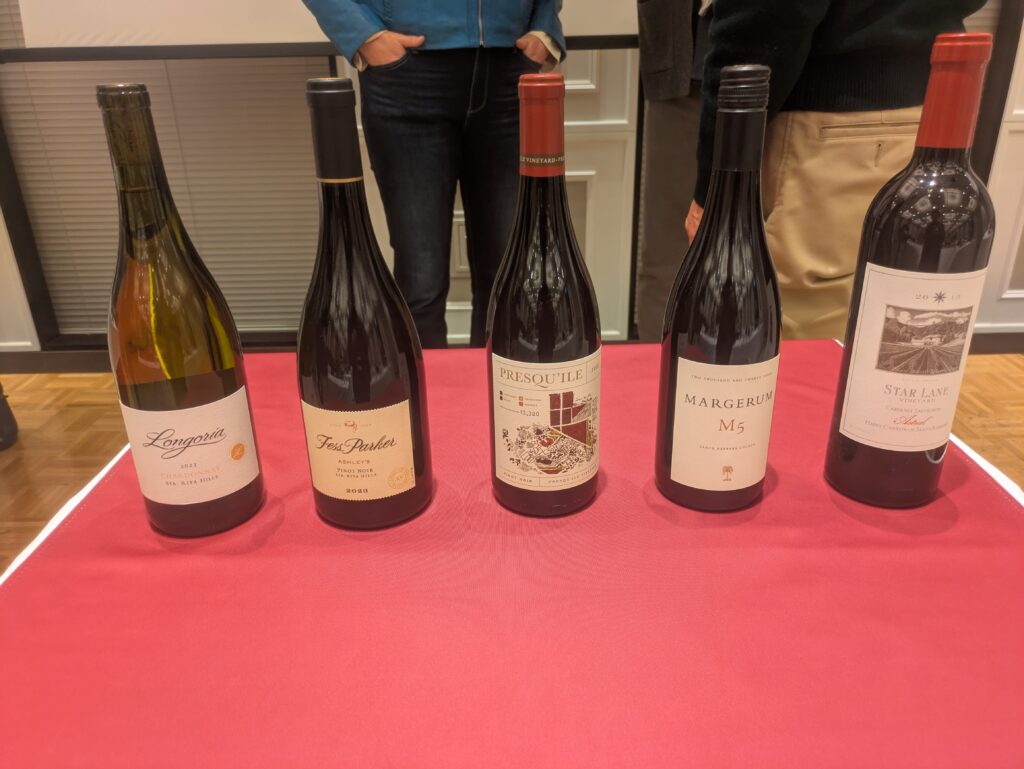
How was it?
Did the charm of Santa Barbara come through to you?
I found it surprising to learn how climate change has made this region cooler (colder) year by year.
Thanks to this, it became clear that wonderfully ripened and refined wines are being crafted here.
At the post-seminar tasting event, I had the opportunity to try many excellent wines, including those not yet imported to Japan.
Overall, my impression was that Santa Barbara produces superb wines that are well-ripened, elegant, and feature extraordinarily fine tannins.
This experience has inspired me, Comny, to pay even closer attention to Santa Barbara from now on.
And with that, we’ll wrap things up for today.
See you next time!
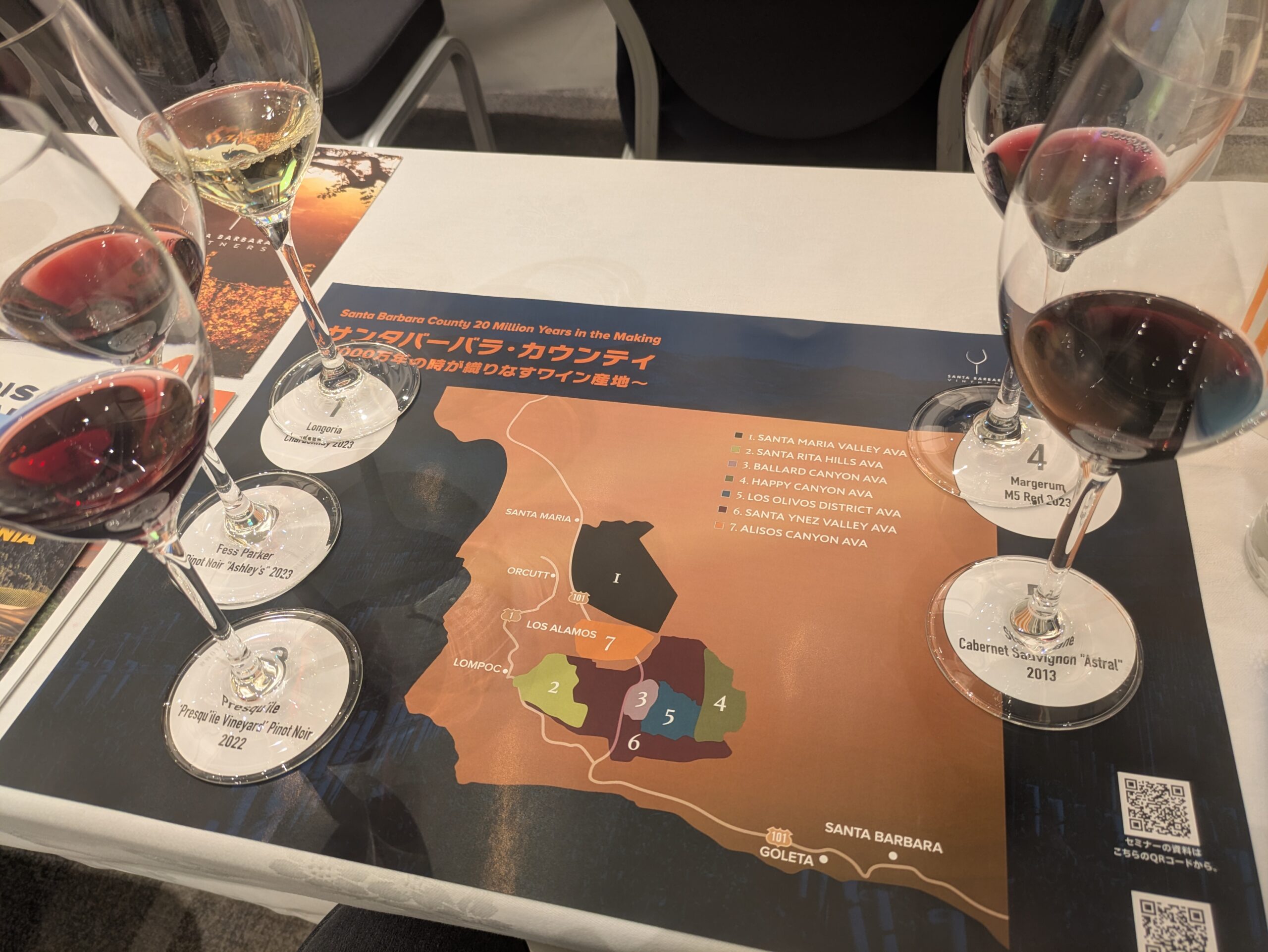




コメント